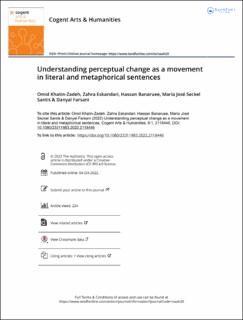| dc.contributor.author | Khatin-Zadeh, Omid | |
| dc.contributor.author | Eskandari, Zahra | |
| dc.contributor.author | Banaruee, Hassan | |
| dc.contributor.author | Seckel Santis, María José | |
| dc.contributor.author | Asadipour Farsani, Danyal | |
| dc.date.accessioned | 2023-01-19T13:51:03Z | |
| dc.date.available | 2023-01-19T13:51:03Z | |
| dc.date.created | 2022-10-24T13:36:09Z | |
| dc.date.issued | 2022 | |
| dc.identifier.citation | Cogent Arts & Humanities. 2022, 9 (1), . | en_US |
| dc.identifier.issn | 2331-1983 | |
| dc.identifier.uri | https://hdl.handle.net/11250/3044690 | |
| dc.description.abstract | Results of the studies on the way language and body coordinate in communication (through language and gesture) have significant implications for language, education, and cognitive studies. However, there is a lack of convenient research in this area analyzing perceptual changes within individuals. To fill this gap, we investigated the embodied realizations of literal sentences representing perceptual changes and metaphorical sentences describing the phenomena in terms of perceptual changes. We classified sentences that referred to a visual, auditory, haptic, gustatory, or olfactory change. Participants listened to four narratives that contained five literal sentences describing a real perceptual change and five metaphorical sentences that described a phenomenon in terms of a perceptual change. We analyzed the recorded videos of the participants. The total number of literal sentences that described a real perceptual change was obtained for each modality (visual, auditory, haptic, gustatory, olfactory) separately. Also, the total number of gestures used with each category of these literal statements was obtained. Only iconic and non-iconic gestures that described such perceptual changes as the movement of an object in the space were counted. The results revealed that gestures accompanied at least 53% of literal and 56% of metaphorical sentences. These results suggest that literal and metaphorical perceptual change sentences could be understood as movements at a conceptual level. The similarity between embodied realizations of literal and metaphorical sentences supports one of the main assumptions of the strong version of embodied cognition. | en_US |
| dc.language.iso | eng | en_US |
| dc.publisher | Taylor & Francis | en_US |
| dc.rights | Navngivelse 4.0 Internasjonal | * |
| dc.rights.uri | http://creativecommons.org/licenses/by/4.0/deed.no | * |
| dc.title | Understanding perceptual change as a movement in literal and metaphorical sentences | en_US |
| dc.title.alternative | Understanding perceptual change as a movement in literal and metaphorical sentences | en_US |
| dc.type | Peer reviewed | en_US |
| dc.type | Journal article | en_US |
| dc.description.version | publishedVersion | en_US |
| dc.source.pagenumber | 13 | en_US |
| dc.source.volume | 9 | en_US |
| dc.source.journal | Cogent Arts & Humanities | en_US |
| dc.source.issue | 1 | en_US |
| dc.identifier.doi | 10.1080/23311983.2022.2118446 | |
| dc.identifier.cristin | 2064436 | |
| cristin.ispublished | true | |
| cristin.fulltext | original | |
| cristin.qualitycode | 1 | |

